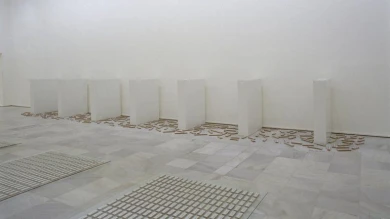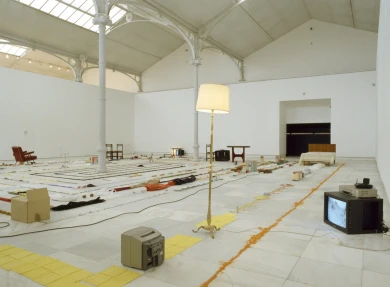Versiones del Sur: Cinco propuestas en torno al arte en América. Heterotopías. Medio siglo sin-lugar: 1918-1968

<p></p>
For this exhibition in the Sabatini building, Puerto Rican Mari Carmen Ramírez and Mexican Héctor Olea address the commission from a complex conception of the exhibition space as a counter-site, where notions of fragility, transience and temporality appear. Heterotopías refers to a place of confrontation and discovery, bringing together important moments of a past which have no location and only come alive in the present. That is how both they both perceive the development of Latin American art, which requires a factor of productivity, criticality, and even investment in the radicalism of the avant-garde.
The exhibition meets these objectives by presenting a selection of key figures and movements in Latin American countries during the twentieth century. The exhibition is structured between the two decades of the establishment of modern Latin American Art (1920 and 1940) and the twenty years between 1950 and 1970, the period of greatest growth, independence and maturity. Facing the historicist paradigm, the curators group the artists and pieces into seven constellations made up of more than four hundred works produced between 1918 and 1968.
The first, "Constelación Promotora" has chosen Barcelona, Paris and Mexico City as the three axes parallel to protoavant-garde Latin America action. Here we find artists such as Dr. Atl, Rafael Barradas, Joaquín Torres-García, José Clemente Orozco, Diego Rivera and David Alfaro Siqueiros.
The "Constelación Universalista-Autóctona" is dedicated to those artists who crave a universal art from native roots and share a concern for the exaltation of races -be they indigenous, mestizo, black or mulatto- as a basis of a common consciousness. Here are the muralists: the Grupo Minoría, Vicente do Rego Monteiro, Joaquín Torres García again and Xul Solar, among others.
It is followed by "Constelación Impugnadora”; this one questions, through art, the injustice perpetrated in Latin America. José Clemente Orozco is followed by artists such as Colombian painter Débora Arango, the Puerto Rican Carlos Raquel Rivera, Argentine artists, followers of Antonio Berni’s philosophies: Jorge de la Vega, Alberto Heredia and Juan Carlos Diestéfano. And as a counterpoint, the works of Venezuelans Carlos Contramaestre and Gabriel Morera are shown.
Dynamic art appears in the "Constelación Cinética” with artists split into two groups. On one hand, Siqueiros, Antonio Berni and Oswald de Andrade and on the other Jesús Rafael Soto, Alejandro Otero, Carlos Cruz-Diez and Gego.
They are followed by "Constelación Concreto-Constructiva" which exhibits the contributions of the trend that comes from constructive and geometric abstraction. The role of the concrete-construction occurs in Argentina, Uruguay, Brazil and Venezuela from the mid-thirties. Some of their representatives are Grupo Madí, Grupo Ruptura, Lygia Clark, Hélio Oiticica, Willys de Castro, Hércules Barsotti and Alejandro Otero.
The splitting of the artistic object which foments the two previous constellations creates a new one, "Constelación Óptico-Háptica", where the senses of sight and touch are a priority for artists like Armando Reverón, Soto, Clark and Oiticica, Cruz-Diez, Cildo Meireles and Mira Schendel.
Finally, the "Constelación Conceptual" exemplifies the great moment of rupture of twentieth century art in Latin America. The purpose of art here is the absolute investment of values. As protoconceptuals, pieces by Waldemar Cordeiro and José Balmes are shown. They are followed by León Ferrari, Luis Camnitzer, Roberto Jacoby and Eduardo Costa, among many others.
Artists
Organised by
Museo Nacional Centro de Arte Reina Sofía
Image gallery


![Exhibition view. Versiones del Sur: Cinco propuestas en torno al arte en América. F[r]icciones, 2000](https://recursos.museoreinasofia.es/styles/small_landscape/public/Exposiciones/2000028-img-001.jpg.webp)
